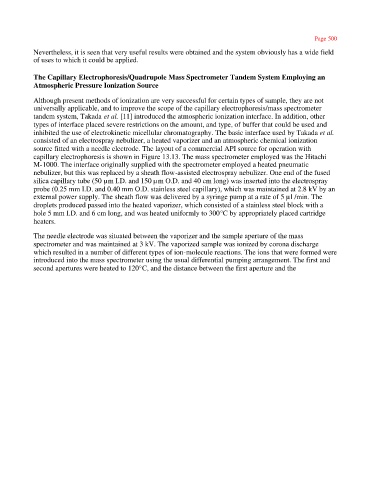Page 514 - Tandem Techniques
P. 514
Page 500
Nevertheless, it is seen that very useful results were obtained and the system obviously has a wide field
of uses to which it could be applied.
The Capillary Electrophoresis/Quadrupole Mass Spectrometer Tandem System Employing an
Atmospheric Pressure Ionization Source
Although present methods of ionization are very successful for certain types of sample, they are not
universally applicable, and to improve the scope of the capillary electrophoresis/mass spectrometer
tandem system, Takada et al. [11] introduced the atmospheric ionization interface. In addition, other
types of interface placed severe restrictions on the amount, and type, of buffer that could be used and
inhibited the use of electrokinetic micellular chromatography. The basic interface used by Takada et al.
consisted of an electrospray nebulizer, a heated vaporizer and an atmospheric chemical ionization
source fitted with a needle electrode. The layout of a commercial API source for operation with
capillary electrophoresis is shown in Figure 13.13. The mass spectrometer employed was the Hitachi
M-1000. The interface originally supplied with the spectrometer employed a heated pneumatic
nebulizer, but this was replaced by a sheath flow-assisted electrospray nebulizer. One end of the fused
silica capillary tube (50 µm I.D. and 150 µm O.D. and 40 cm long) was inserted into the electrospray
probe (0.25 mm I.D. and 0.40 mm O.D. stainless steel capillary), which was maintained at 2.8 kV by an
external power supply. The sheath flow was delivered by a syringe pump at a rate of 5 µl /min. The
droplets produced passed into the heated vaporizer, which consisted of a stainless steel block with a
hole 5 mm I.D. and 6 cm long, and was heated uniformly to 300°C by appropriately placed cartridge
heaters.
The needle electrode was situated between the vaporizer and the sample aperture of the mass
spectrometer and was maintained at 3 kV. The vaporized sample was ionized by corona discharge
which resulted in a number of different types of ion-molecule reactions. The ions that were formed were
introduced into the mass spectrometer using the usual differential pumping arrangement. The first and
second apertures were heated to 120°C, and the distance between the first aperture and the

